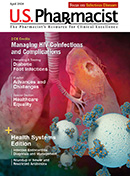US Pharm. 2009;34(1):2.
I spent most of my twenty-plus years of practicing pharmacy firmly planted on the retail side of the profession. When I graduated from pharmacy school, all pharmacy graduates had to intern for a year before they were eligible to take the licensing exam. We did not have the luxury of doing rotations during our fifth year as students do today. But I took the first three years out of pharmacy school to try out all the various disciplines. I worked in a supermarket, a chain, an independent, and a hospital. Because I longed for the business side of pharmacy and the greater patient interaction that retail had to offer, my stint in the hospital was short. But it opened my eyes to a side of pharmacy to which I had not yet been exposed. All these years I haven't been able to shake the feeling that while health-system pharmacists are an essential asset to the health care system in this country, they basically remain invisible to the general public.
And while the hospitalized patient may never get to actually meet the pharmacists who filled their prescriptions during their hospital stay, the health-system pharmacists and the pharmacies they work in have evolved over the years into state-of-the art technological marvels that few retail pharmacists can really appreciate. I recently attended the 43rd Annual American Society of Health-System Pharmacists (ASHP) Midyear Clinical Meeting. I've attended this meeting for nearly 20 years, and each year I am amazed at the array of technology that is available to pharmacists who work in the hospital setting.
The ASHP recently conducted a survey of pharmacy practice in hospitals that was unveiled at the meeting. The results helped explain the huge amount of hardware and software being displayed on the exhibit floor. For example, the survey showed that nearly 83% of hospitals utilize automated dispensing cabinets as part of their distribution model; 10% utilize robotic dispensing. Compared to the robotics I personally saw demonstrated, the counting tray found in many retail drug stores looks like an abacus next to a computer. Bar coding is used by about a quarter of the hospitals surveyed as a way to verify accuracy before dispensing, a fivefold increase over the past six years. And speaking of accuracy and safety, the survey uncovered that 90% of the hospitals polled said their automatic dispensing cabinets are interfaced to the pharmacy information system, requiring pharmacist-order review and approval before the drug is dispensed.
And forget the days when "invisible" health-system pharmacists like me were stuck in some out-of-the-way area in the basement of the hospital all day with little or no patient interaction. The survey revealed that nearly two-thirds of the hospitals reported their staff pharmacists as having an integrated role in both distributive and clinical activities. And the number of hospitals that have pharmacists in emergency departments has doubled over the past two years.
Every year I come away from the ASHP meeting with the feeling that while the health-system pharmacist may be a rare breed to many retail pharmacists, in the end all pharmacists are prepared in the same mold--a mold that makes sure that the dispensation of drugs is done by well-trained professionals who are elevating the quality of health care delivered in the United States.
To comment on this article, contact editor@uspharmacist.com.






